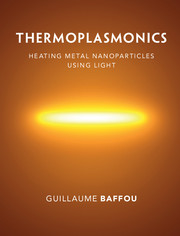Book contents
- Frontmatter
- Dedication
- Contents
- Foreword
- Preface
- 1 Nanoplasmonics
- 2 Thermodynamics of Metal Nanoparticles
- 3 Numerical Simulation Techniques
- 4 Thermal Microscopy Techniques
- 5 Thermal-Induced Processes
- 6 Applications
- Appendix A Dimensional Analysis
- Appendix B Thermodynamical Constants
- Appendix C Thermal Green's Function for a Three-Layer System
- Index
Foreword
Published online by Cambridge University Press: 26 October 2017
- Frontmatter
- Dedication
- Contents
- Foreword
- Preface
- 1 Nanoplasmonics
- 2 Thermodynamics of Metal Nanoparticles
- 3 Numerical Simulation Techniques
- 4 Thermal Microscopy Techniques
- 5 Thermal-Induced Processes
- 6 Applications
- Appendix A Dimensional Analysis
- Appendix B Thermodynamical Constants
- Appendix C Thermal Green's Function for a Three-Layer System
- Index
Summary
In the spring of 1999 I was working at my desk at C. P. M. O. H. (Centre de physique moléculaire optique et hertzienne) in Bordeaux when I received an unexpected phone call from Claude Boccara from E. S. P. C. I. (École supérieure de physique et de chimie industrielles de la ville de Paris) in Paris. Claude had been particularly interested in photoacoustic and photothermal spectroscopies, as he had used them to optimize the mirrors of the VIRGO gravitational wave detector. He asked me about work by a Japanese colleague – it turned out to be Tsuguo Sawada from Tokyo University – who used a thermal-lens microscope to detect very weak concentrations of molecules, potentially even down to single molecules. I did not know the work, but as we were thinking of detecting single molecules at room temperature through their absorption instead of their fluorescence, I was immediately thrilled to learn about this new possibility. Some weeks later, I attended a talk by David A. Schultz from San Diego about applications of gold nanoparticles in bioimaging. Putting these two pieces of information together, I proposed that my young colleagues Philippe Tamarat and Abdelhamid Maali should start with the photothermal detection of gold nanoparticles instead of trying the absorption of single molecules at room temperature. Indeed, these gold nanoparticles neither bleach nor blink, and they exist in different sizes. This makes it much easier to optimize a technique on large nanoparticles before attempting to detect smaller ones. Contrary to the work of Tsuguo Sawada and Takehiko Kitamori, who investigated fluid suspensions in which diffusing molecules could enter and leave the detection volume during the detection period, we decided to work on immobilized gold nanoparticles, with which we had previous experience. A further advantage of photothermal detection was the high-frequency modulation of the heating beam, leading to very efficient rejection of background scattering by the sample and of low-frequency noise, both appreciable features in the complex and heterogeneous environment of biological cells. This project eventually led to our group's first work on photothermal detection, published in 2002. Later work by Brahim Lounis’ group6 and by others has established the thermal-lens microscope as a unique tool for the detection of single absorbing objects down to individual molecules.
Information
- Type
- Chapter
- Information
- ThermoplasmonicsHeating Metal Nanoparticles Using Light, pp. ix - xiiPublisher: Cambridge University PressPrint publication year: 2017
